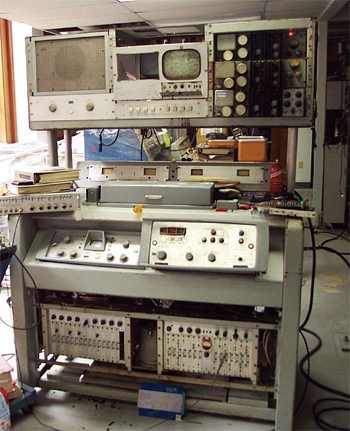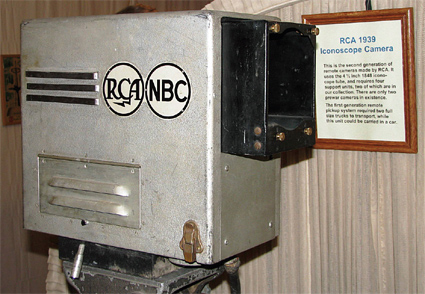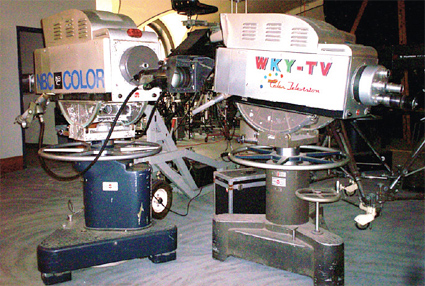Keeping Early Television's Legacy Alive
ALEXANDRIA, VA.—In this world of handheld HD, 3DTV origination, and flat screen displays, it's easy to take television's roots for granted. We've arrived in the 21st century with some incredibly good gear—tiny cameras with auto-setup, big assemblages of hard drives, powerful computers and the ubiquitous black, beige and blue boxes that tie everything together. Beautiful pictures are consistently produced with miniscule amounts of light, there's almost nothing to maintain (or at least that can be fixed in the field), and just about everything comes with a very unimpressive footprint.

This very unique high-banded Ampex VR-1000 is shown undergoing an initial checkout at the Museum of Broadcast Technology. The VTR has since been restored to operational status.NO PLASTIC 'TINKERTOYS' THEN
Once upon a time, broadcasters had to really work to get something on the air, especially if it took place outside the confines of a comfy studio. Camera heads weighed hundreds of pounds, video recording was done on half-ton machines that needed dedicated power and couldn't pass through ordinary doorways. Camera cable could be measured in pounds-per-foot. Color monitors were extremely finicky and came in shipping crates with roughly the same dimensions as student rooms at some colleges. A typical STL occupied the better part of a rack. And while many of today's equipment prices seem high, in looking back, they are positively bargains—in today's money, an early color camera could easily run $600,000, and VTRs were even more expensive.
Those of us who have been in the business long enough will certainly remember such equipment, and maybe once in a while, we may have a hankering to see it again, or possibly impress our children or grandchildren with apparatus once used in our careers.
Where have all of these objects that were so near and dear to us—and absolutely necessary to put a picture on the air just a few years ago—gone?
Unfortunately, far too many have been recycled into car bodies or beer cans. Others now repose in landfills, corroding away. Luckily, a small amount has been saved to be savored by present and future generations.
So where do you go if you'd like to feast your eyes on an Ampex quad tape machine or early RCA camera?
Chances are it won't be in the large "mainstream" museums such as Washington's Smithsonian Institution or Chicago's Museum of Science and Industry. Such institutions may have early broadcast gear, but it's generally relegated to back rooms or remote warehouses. Associate curator of the electricity collection at the Smithsonian's Museum of American History, Hal Wallace, explains: "This, in general ties into the evolution of museums within the last half century or so," said Wallace. "A hundred years ago, if you had a technology exhibit, you'd put up all of the items surrounding that technology—radio tubes and the like. During the last 50 years there's been a shift to focusing more on society and technology. This mirrors the shift from a very progressive view of technology to a view of its consequences—sometimes not so good, such as pollution. Museum exhibits have changed to reflect that."
BLEACHED BONES FROM TV'S PAST

This is what a field camera looked like in television’s infancy. (The lens is mounted inside the housing.) It’s on display in Ohio’s Early Television Foundation Museum. However, there are still some institutions that do feature legacy broadcasting gear. These are more numerous than one might suspect, given the amount of space that such equipment occupies and the difficulty and cost involved in restoring it to a presentable (and sometimes operational) state. The thrust of this article is to identify and salute several of these broadcast equipment repositories that do allow close-up inspection of earlier broadcasting technologies, mostly from companies that have long departed from the broadcast television arena—Ampex, CBS Labs, Conrac, Dumont, Federal, General Electric, Riker, Miratel, Sarkes Tarzian, International Nuclear, IVC, Philco, Raytheon, RCA, REL, Telechrome, Visual, Electronics, Vital Industries, Wickes—please feel free to add you own favorite brands.
WHERE THE 'GOOD STUFF' LIVES
With that as preface, where do you go to see, for instance, an iconoscope camera?
"We have a 1939 RCA camera on display," said Geoff Bourne, president and curator at the Museum of Radio and Technology in Huntington, W.Va. "All in all, we have probably five or six thousand items in our 10,000 square foot display area. At least 10 to 20 percent are broadcast-related; probably half of that relates to television. We have several VTRs, including an RCA TR-50. There's also an RCA TP-16 projector and (optical) multiplexer."
Bourne doesn't have a monopoly on early cameras, though. In the Columbus, Ohio suburb of Hilliard, there's the Early Television Foundation and Museum, which contains a very large collection of TV artifacts. One of these is another 1939 RCA "ike" camera. There's also a 60-line mechanical scanner installed in its own chamber that museum visitors can enter to be televised, 1920's-style. The museum's founder, Steve McVoy, has also located and acquired a very large number of extremely rare pre-WWII television receivers. Early color sets, are equally well represented, including some that were designed for receiving CBS's short-lived field sequential broadcasts. And unlike a lot of museum equipment, many of McVoy's vintage television sets and monitors have been restored to operational condition. Visitors can also inspect a 1948 RCA television remote truck that's still fitted with image orthicon cameras and a vacuum tube microwave transmitter. Another equally impressive item is a complete RCA TT5-A television transmitter.

These 300+ pound beasts (RCA TK-41 and TK-40) were once the only way to way to produce live color. They now live on at the Museum of Broadcast Technology.LOTS OF QUADS
In terms of operational broadcast television equipment, the Museum of Broadcast Technology in Woonsocket, R.I., probably holds the title, with more quad VTRs up and running than most TV stations and early production houses ever had on line.
"We have seven working quad tape machines spread out over a number of models," said Tom Sprague, who along with Henry Berman and Paul Beck, helped establish the museum. "The oldest thing we have is kind of a rarity, an Ampex VR-1000HB. It was modernized and high-banded by Ampex with solid-state electronics. This is a working machine."
The museum also has a working RCA TR-22, a working TR-60 and TR-70 and three working TR-600s, as well as a complete RCA TCR-100 (the seminal cartridge tape format broadcast recorder/player) with an SP-100A signal processor. "It's a very complete machine," Sprague said "It may be this winter's big project." (Earlier in his career, Sprague was with the RCA service company and taught classes on the TCR-100.)
Jay Ballard, the museum's restoration director, notes that VTRs aren't the only operation part of the establishment.
"I specialize in cameras and we now have six RCA TK-44s up and running," said Ballard. "We want to show to the public that we used to make this stuff in this country and did a lot of pioneering, especially in the post-WWII era when broadcasting really meant something."
He observed that one of the biggest obstacles in bringing camera chains back to life is the lack of support electronics. In many cases, the camera heads were saved, but the CCU, lenses, heads and pedestals were jettisoned. Open deflection yokes and deteriorated optical components, especially beam splitters, also slow down restoration efforts.
(This special feature on U.S. museums featuring broadcast equipment continues in the next edition of TV Technology.)
Get the TV Tech Newsletter
The professional video industry's #1 source for news, trends and product and tech information. Sign up below.
James E. O’Neal has more than 50 years of experience in the broadcast arena, serving for nearly 37 years as a television broadcast engineer and, following his retirement from that field in 2005, moving into journalism as technology editor for TV Technology for almost the next decade. He continues to provide content for this publication, as well as sister publication Radio World, and others. He authored the chapter on HF shortwave radio for the 11th Edition of the NAB Engineering Handbook, and serves as editor-in-chief of the IEEE’s Broadcast Technology publication, and as associate editor of the SMPTE Motion Imaging Journal. He is a SMPTE Life Fellow, and a Life Member of the IEEE and the SBE.

